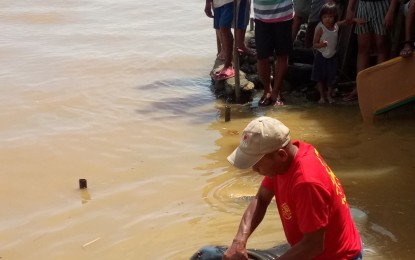
MEGAMOUTH SHARK. A fisherman holds the head of the megamouth shark that was unintentionally caught as residents look on in Barangay Cugman, Friday morning. (Photo courtesy of Menzie Montes)
CAGAYAN DE ORO CITY – A megamouth shark that was unintentionally caught by a fisherman off Macabalan Bay Friday morning may have ventured into shallower waters to look for food, an officer from the Bureau of Fisheries and Aquatic Resources-10 (Northern Mindanao) said.
BFAR-10 fishing regulation officer Cheryl Magante said the megamouth shark, which weighs about 400 kilograms, was 3.048 meters long, and a meter wide.
According to oceana.org, the megamouth shark is the smallest of the three species of filter-feeding sharks. Its weight can reach up to 1,215 kilograms.
Magante said it was still alive when it got entangled in the fishing net of a fisherman in Barangay Cugman.
“It was wounded and was still alive when it got trapped in the net,” Magante said, quoting the testimony of the fisherman.
But when BFAR-10 officials reached the area, residents already slaughtered the megamouth shark and sliced its flesh for food, she said.
She said based on Republic Act 8550 or Philippine Fisheries Code of 1998, killing and slaughtering of megamouth sharks is prohibited, although she added they have not taken any legal action as they have not identified who killed it and who ate its meat.
Maganted said they were only able to recover about half of the fish and its tail, which they buried in Barangay Kauswagan.
She said it was possible that the megamouth shark was following the trail of krills, one of its foods, when it got caught in the fish net.
Although megamouth sharks can usually be found in deep waters, some of them were seen in shallower waters in recent months.
“Earlier this year, a group of seven or eight megamouth sharks were sighted just near the shore of Cugman,” Magante said.
In the past years, megamouth sharks and whale sharks, locally known as “tawiki,” were sighted in Macajalar Bay and nearby municipal waters.
In the coastal municipality of Talisayan in Misamis Oriental, the townspeople used to celebrate the “Tawiki Festival” due to the abundance of whale sharks in the area.
The people of Talisayan call megamouth sharks as “Tanguy-tanguy,” a local mushroom, because of its soft body similar to that variety of fungus, said photographer and writer Elson Elizaga in his blog article about megamouth sharks. (PNA)
